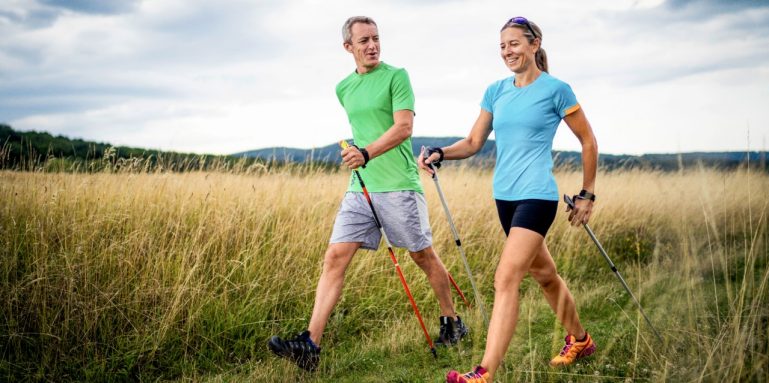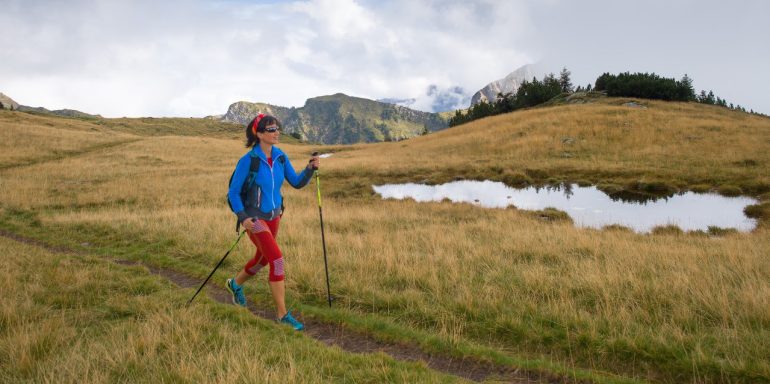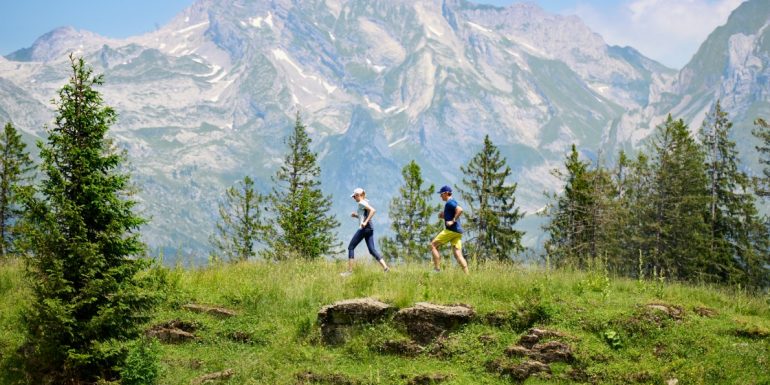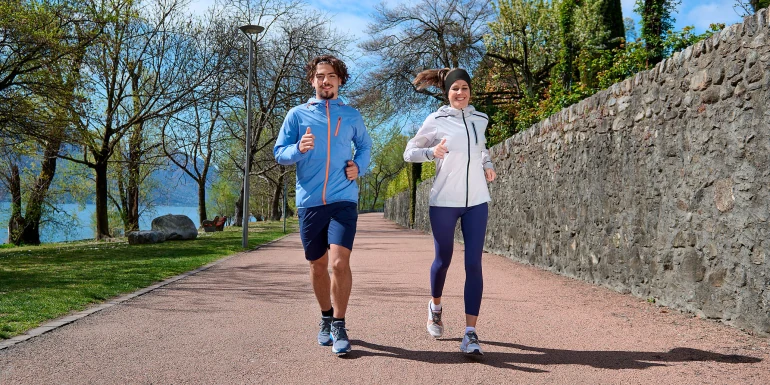
How to get the most out of Nordic walking
Nordic walking is an effective full-body workout. However, it’s not as easy as it looks. It involves a complicated sequence of motions, so mistakes creep in all too easily.
Nordic walking is a great form of exercise that combines efficiency with a low risk of injury. It also has a positive impact on your health: You get plenty of fresh air, and it improves your cardiovascular fitness and increases your metabolism. Nordic walking also strengthens up to 90% of your muscles and relieves tension. If you use the poles correctly.
Nordic walking: The right technique
To obtain the desired results from Nordic walking and prevent health-related problems, using the right technique is crucial. Our brief guide to Nordic walking will help you to learn the ins and outs of the technique.
How to walk more effectively:
- Straighten up and always look ahead.
- Keep your shoulders relaxed and down.
- Hold your poles close to your body.
- Take a step forward with your left foot and at the same time, swing your right arm forward. Your left arm moves back. Try to straighten your left arm as much as possible.
- Hold on to the handle of the right pole but let go of the left pole – it is secured to your wrist with a strap, so you cannot lose it.
- Plant your right pole on the ground just in front of your right foot, i.e. directly under your centre of gravity. When your pole hits the ground, make sure to grab the handle again.
- The tips of your poles should always be pointing diagonally backwards.
- You should also engage your torso and hips in the movement.
- Take slightly longer steps than when walking normally.
- Roll through your entire foot and push off with the ball of your big toe.
- If you’re leaving visible marks in the ground with your poles, you’re doing it right.
The ALFA technique covers the four most important points of Nordic walking technique:
A= Appropriate posture
L= Long arms
F= Flat poles
A= Adapted stride length
Nordic walking uphill:
Walking uphill will put a greater strain on your arms. Make sure you always give yourself a bit of a run-up.
Nordic walking downhill:
Make sure you always bend your knees slightly. This gives you a lower centre of gravity. Reduce your stride length slightly. You can use your poles to slow yourself down.
Move. Earn points. Benefit.
Helsana+ rewards your dedication, whether you’re jogging, walking or hiking. Simply download the Helsana+ app, connect your tracker watch or smartphone and start collecting points. Your activity will earn you valuable Plus points that you can convert into cash, vouchers or donations. You can collect over CHF 300 per year.
Common mistakes made by Nordic walkers
Getting the Nordic walking technique right requires some practice. Try to avoid the following:
- Don’t hold the poles too far away from your body and don’t plant them too far ahead of you.
- Don’t use the poles to prop yourself up on. (Exception: walking downhill)
- Make sure you’re not taking too long strides.
- Don’t straighten the knee on your front leg.
- Swing your arms like pendulums. Never flex them as far as 90 degrees.
The wrong technique can put undue pressure on your knees, hips and back, and damage your joints. Seek expert advice if you are unsure about anything. This can help you to optimise your Nordic walking technique.
The right Nordic walking equipment
Carbon fibre or graphite poles are lighter in weight than aluminium poles. They also vibrate less. The point where the strap attaches to your poles should be at the height of your navel (without rubber stoppers).
Adjustable poles provide greater flexibility, but tend to be heavier and break more easily. You should also make sure your poles have a wrist strap, non-slip grips and moisture-wicking material around the handle. Depending on the surface you will be walking on, you can attach metal spikes or rubber stoppers to your poles.
Tip: don’t use ski poles as a substitute for Nordic walking poles.
Wear sturdy shoes with a good profile that fit well and have a flexible sole. Wear breathable, comfortable clothes. If you are prone to blisters on your hands when doing Nordic walking, it might be a good idea to wear cycling gloves.
Further information



Newsletter
Find out more about current health issues every month and get all the information you need about our attractive offers from all Helsana Group companies * delivered by e-mail to read whenever it suits you. Our newsletter is free of charge and you can sign up here:
- Ms
- Mr
We did not receive your information. Please try again later.
* The Helsana Group comprises Helsana Insurance Company Ltd, Helsana Supplementary Insurances Ltd and Helsana Accidents Ltd.
